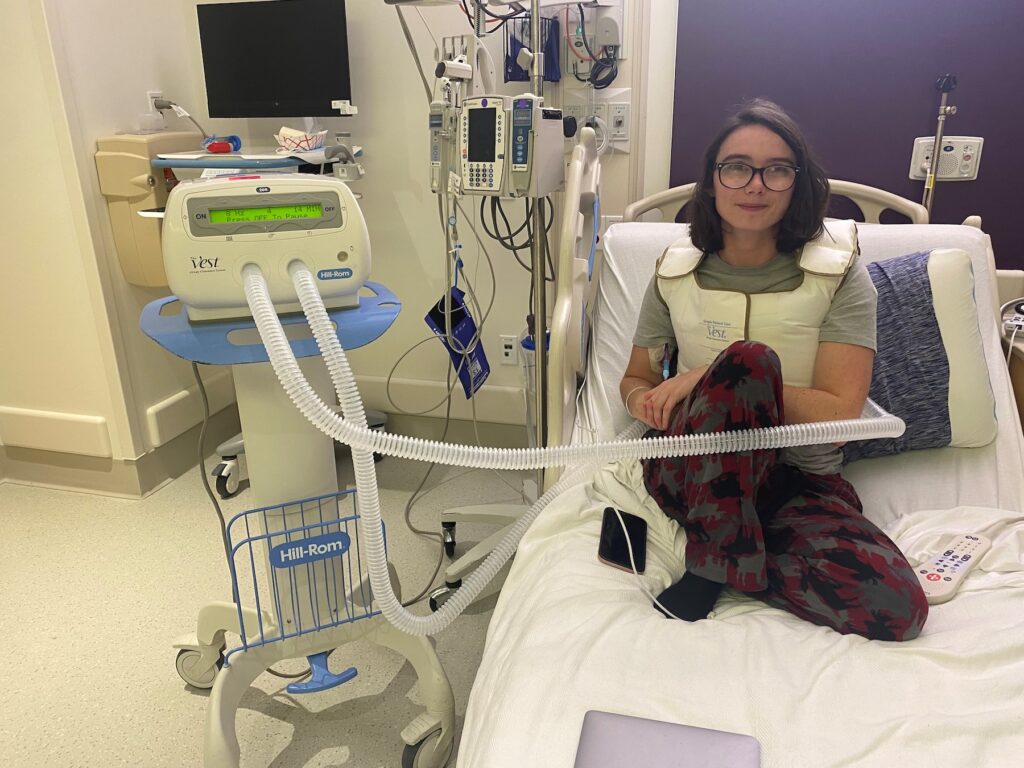
The author’s daughter, Rose Keller, during a recent inpatient stay at Boston Children’s Hospital. (Photo courtesy of Donald Kreis; image of Rose Keller used with her permission)
My daughter’s annual pharmacy bill is routinely a multiple of my salary as a state employee whose family relies on the health benefits that come with my job. That grim fact is always top-of-mind, but especially now as I read a remarkable document: the latest annual report of New Hampshire’s Prescription Drug Affordability Board (PDAB).
Cystic fibrosis – a genetic, chronic condition that slowly ruins lungs and other organs – is the reason my 23-year-old kid takes the prescription medication Trikafta. This breakthrough drug is the main reason that most people with CF can now expect to live well into adulthood and beyond.
Alas, according to the PDAB annual report, Trikafta is also the most expensive drug in New Hampshire – or, at least, the most expensive among those covered by health plans for state employees and retirees. The average total cost is $260,413 per year.
What makes the PDAB annual report noteworthy, however, is not just that it offers up factoids like that as illustration of just how much the bloated cost of cutting edge prescription medications is driving the cost of health care to unsustainable levels. The PDAB report then goes on to explain exactly what the problem is, in blunt and unmistakable terms.
“Distinct from every other industrialized and wealthy nation, the U.S. allows pharmaceutical manufacturers to set launch prices and raise list prices at will,” the report notes. “These exorbitant costs … exert upward pressure on premiums for all plan beneficiaries as health plans and employers struggle to balance the demand of these treatments and all other health care services.”
Maybe you’ve never heard of Trikafta. But also on the list of the most expensive prescription medications in New Hampshire are names that are more well-known: blockbuster weight-loss drugs like Ozempic and Wegovy, the blood thinner Eliquis, and Humira, which treats arthritis. In total dollar terms, Humira imposes the biggest bill of all (about $22 million for the public employee health plans covered by the report).
New Hampshire is one of 11 states with a PDAB, and the latest annual report illustrates why we are lucky to have such a body. The pretext for having such a body is the need to help the state save money on the cost of insuring its employees, but there is great value to the light shed by the board on costs we all incur as consumers of health care and health coverage.
Not all PDABs are alike. Unlike ours, the Colorado PDAB has explicit authority to set an “upper price limit” on highly expensive prescription medications. Trikafta happens to have been the first drug it considered for such action, with unsettling results.
Owing to intense lobbying from patient groups and CF caregivers, who have succumbed to propaganda (and financial help) from the pharmaceutical industry, the Colorado PDAB actually declared Trikafta to be “affordable” a year ago despite a price similar to the one just publicly reported in New Hampshire. That one hit home, in part because my daughter was vilified by others in the CF community for testifying before the Colorado PDAB. She made her dad proud by arguing that no drug with a price tag of that magnitude could possibly be considered affordable. Keep in mind that many prescription drug plans include copays of 20 percent – which, for a $260,000 medication, means $52,000 a year out of pocket.
Though New Hampshire’s PDAB statute does not authorize the board to set upper price limits, there is enormous value in having a government agency describe this crisis so forthrightly and factually. The PDAB report notes that “the pharmaceutical market is notoriously opaque,” which is quite an understatement. What makes the report so powerful is its comprehensive disclosure of drug pricing data the industry usually succeeds in keeping secret.
Therefore it should surprise no one that the pharmaceutical industry is constantly trying to kill off the PDAB, which is really still just gearing up after four budget-starved years. The board’s new executive director, Kirk Williamson, deserves our thanks as the principal author of the report. So does the PDAB’s chair, Claremont Democratic Rep. Gary Merchant, a retired pharmacist who knows how important this work is.
In just three years – maybe sooner, if the Affordable Care Act goes down, as some fear – my daughter will turn 26 and will no longer be covered by her dad’s state employee health plan. But even if she could stay on my plan forever, and even though my daughter means the world to me, I cannot simply expect my fellow taxpayers and premium payers to cover drug costs of that magnitude.
That’s why I am so grateful for our Prescription Drug Affordability Board and urge my fellow citizens to give its latest annual report a read.

